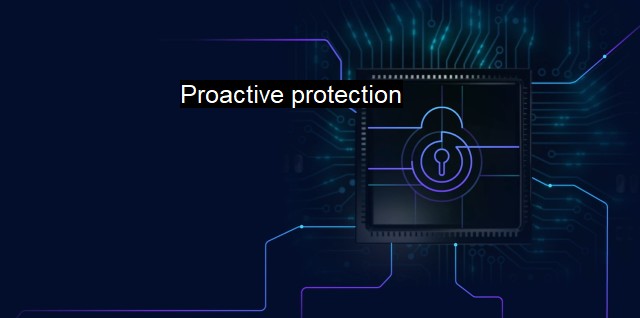What is Proactive protection?
Maximizing Security: The Vital Role of Proactive Protection in Cybersecurity and Antivirus
Proactive protection refers to the approach used in cybersecurity and antivirus technology that focuses on detecting, neutralizing, and eliminating threats before they negatively impact a network, system, or machine. It helps to address the potential vulnerabilities and threats in your digital framework even before any attacks occur. This strategy is in stark contrast with the conventional reactive approach, characterized by actions taken after an attack has happened. The proactive methods go beyond just waiting for a cyber threat and then acting upon it. Instead, they actively trace and prevent an abundance of potential threats.Proactive protection can also be seen as the next-level line of defense designed for the persistent threats present in the current state of cyber affairs. It involves a strong blend of technology and human analytics to proactively identify loopholes in cybersecurity fences and patch them up before attackers can exploit them. The overall emphasis remains on prevention which, according to the old adage, is always better than cure.
There are several components in robust proactive protection strategies that help in successfully countering cyber threats. For instance, antivirus solutions play a crucial role in offering proactive protection by actively monitoring the system to detect and eliminate any malware or viruses. A modern and quality antivirus solution doesn't just detect known viruses from its extensive database but also tracks any abnormal behaviors or patterns in the system pointing towards a cyber threat. Employing artificial intelligence and machine learning technologies, today's antivirus solutions can evolve continually to identify novel forms of malicious software.
Another key area is cybersecurity awareness training. Expanding knowledge and awareness about potential cyber threats and offering employees ways to safely navigate through the internet can effectively act as both a preventive and a deterrent against cyberattacks. A heft of cyber invasions in corporations and organizations originate from employee negligence or ignorance while dealing with potentially harmful emails, links, or software. Hence, regular training and updates on safe computing practices, latest threat scenarios and simulations become essential.
Administering system, data and network audits also make up for a significant part of proactive protection. Regular audits help assess the vulnerabilities in the data or network. Vulnerability assessments or penetration testing is also a smart approach, where IT professionals deliberately attempt to breach your systems to spot weakness points.
Patching and updating equilibrium is another armed fronts of proactive protection. In an interconnected world where software, apps, plug-ins, and programs get continually updated, maintaining these updates forms the cornerstone of cybersecurity, since most of them are essentially security enhancements and bug fixes aimed to fight against recent threats.
Regularly carrying out disaster recovery and business continuity tests can also play a significant element in proactive protection. A well-maintained backup acts as an extremely reliable shield in case all fails and the system undergoes a severe attack.
Concluding it all, proactive protection is an advanced approach to cybersecurity, majorly aiming to stop an attack before it happens instead of reacting to it. It's achieved by effective antivirus, regular training and audits, timely patching and updates, structured system recovery, and other similar preventive measures. While proactive protection cannot provide complete assurance against all cybersecurity threats, it forms a solid base that is far more effective in responding to the rapidly evolving landscape of cyber threats.

Proactive protection FAQs
What is proactive protection in cybersecurity?
Proactive protection refers to security measures designed to anticipate and prevent potential cyber threats before they can cause damage or harm to a system. It involves deploying tools and protocols that can detect and neutralize threats before they are able to compromise a network or system.How does proactive protection differ from traditional antivirus protection?
Traditional antivirus protection is reactive, meaning it can only detect and respond to known malware and cyber threats. Proactive protection, on the other hand, uses advanced analytics and machine learning algorithms to identify and stop unknown threats in real-time. This allows for more comprehensive protection against rapidly evolving cyber threats.What are some examples of proactive protection measures?
Some examples of proactive protection measures include intrusion detection systems, vulnerability scanning, network segmentation, and real-time threat intelligence monitoring. These tools allow for early detection of potential threats and enable security professionals to respond quickly and effectively to protect their systems.Why is proactive protection important in cybersecurity?
Proactive protection is important in cybersecurity because cyber threats are constantly evolving and becoming more sophisticated. A proactive approach to security can help mitigate the risk of cyberattacks and reduce the potential damage and cost associated with a successful breach. It allows for faster detection and response, leading to better overall security posture and protection of sensitive data.| | A | | | B | | | C | | | D | | | E | | | F | | | G | | | H | | | I | | | J | | | K | | | L | | | M | |
| | N | | | O | | | P | | | Q | | | R | | | S | | | T | | | U | | | V | | | W | | | X | | | Y | | | Z | |
| | 1 | | | 2 | | | 3 | | | 4 | | | 7 | | | 8 | | |||||||